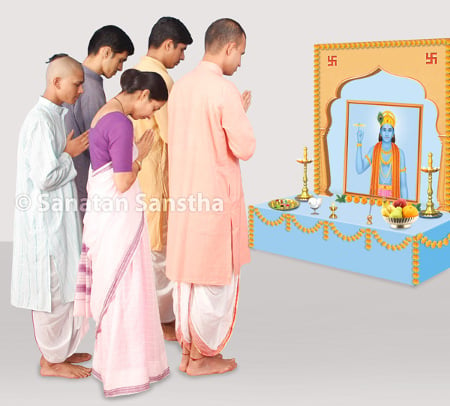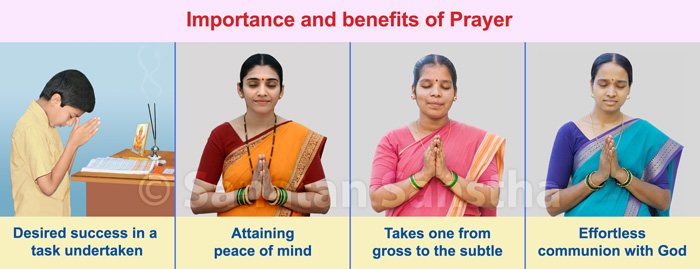Praying is essential for understanding God and for perceiving His existence through our body, mind and intellect. Praying to God at short and regular intervals makes it easier to establish communion with God. This article elaborates types of prayers and the benefits one can derive at various levels including activity, thought and attitude.
1. Origin and meaning
A. Origin
In Sanskrut language, the word for prayer is prarthana. It is formed by combining words, ‘pra’ meaning ‘intensely’ and ‘artha’ meaning ‘to plead’.
B. Meaning
‘With intense humility unto God, pleading with yearning for a desired aspect is termed as a ‘prayer’. A prayer includes respect, love, pleading and faith. A prayer expresses the helplessness of the devotee and his state of surrender, and he keeps offering his doership to God.’- Vaidyacharya (Dr.) Vasant Balaji Athavale, Chembur, Mumbai (Year 1980)
2. Importance
A. Developing love and respect for a Deity

‘With the aim of developing closeness with God and the Deities and to develop love and respect for them, we should pray. Praying creates awareness that ‘God, Deity and Guru are going to get everything done through me.’
B. Success in a task
When a desired task is undertaken after praying to a Deity, the task is blessed by the Deity. Besides, praying increases our Atma-shakti (Energy of the soul) and confidence. As a result, the task achieves excellence and success.
C. Attaining peace of mind
While performing a task after praying, peace of mind is attained and a task performed peacefully and with a steady mind is done well.’ – Ms. Anuradha Wadekar, Sanatan Sanstha (23rd May 2009)
D. An easy method of worship that
takes the worshipper from the gross to the subtle
People worship God to attain peace of mind in a demanding day-to-day life and to gradually move towards God-realisation. Most people, however, continue performing daily ritualistic worship and other religious rituals that are a part of Karmakanda (Spiritual practice of rites, rituals and observances performed at the physical level) all through their life. Worship according to Karmakandais at a gross level. God, however, is subtle in nature. Thus, worship to attain God should be one that takes us from the ‘gross to the subtle’. A prayer offered to God is at the mental level and hence, it an easy form of worship that takes us from the ‘gross to the subtle’.
E. An effortless path of communion with God
While performing sadhana (Spiritual practice), remaining in communion with God is important. Praying to God at short and regular intervals makes it easier to establish communion with God.
F. Faith and bhav (Spiritual emotion) for the Deity are generated
Due to the prayer, a Deity showers grace and spiritual experiences are its result. This helps to generate faith and bhav for the Deity.
G. Importance of a collective prayer

‘Collective prayers and hailing of God by children generate a specific harmonious reverberation that is capable of generating Holy waves in the environment. At such times, the mind concentrates on the sound due to which the faculties of memory and hearing develop further. Therefore, a collective prayer is considered important in schools.’ (Monthly ‘Rushi Prasad’ November 2010)
3. Benefits

A. Praying offers worldly and spiritual benefits
‘That a prayer offers both worldly and spiritual benefits to an individual has now been proved through scientific experiments too.’ (Monthly ‘Rushi Prasad’ November 2010)
B. Praying imparts benefits at all
the three levels of activity, thought and attitude
1. Activity
Praying makes an activity abound in bhav, leading to fewer mistakes in the activity and hence, the seva unto God or Guru turns out as expected.
2. Thought
So long as the mind is active, thoughts are bound to appear in it. Thoughts obstruct the dissolution of the mind. Undesirable thoughts also result in misuse of energy of the mind. Praying is useful in preventing this misuse. Praying reduces anxiety and increases contemplation.
3. Attitude
Due to praying regularly, its impression is created on the mind and contemplation starts on it. Therefore, the attitude of an individual or a seeker starts becoming introverted.
C. Removal of mental stress
1. ‘When under mental stress, remembrance of God through a prayer relieves the stress and we are reminded of chanting God’s Name too.
2. Due to a prayer, doership of a task or seva is offered to God and hence, the mind is not stressed.’
– Ms. Bhakti Parkar, Sanatan Ashram, Devad, Maharashtra (Chaitra Krushṇa 4, Kaliyug Varsh 5111 [13th April 2009])
D. Reduction of ego
Ego generates unhappiness in human life. Man surrenders unto the all-powerful God through the medium of a prayer. He pleads to God through a prayer. This helps in early reduction of his ego.
E. Early dissolution of mind and intellect
‘Atmanivedan (Conversation with God with an emotion of surrender) unto God, constant praying and expression of gratitude lead to early dissolution of the mind and intellect.’ – H.H. Dr. Athavale (5th December 2007)
F. Forgivance by God or Guru
When an individual who has committed a mistake surrenders unto God or Guru through a prayer, they forgive him.
4. Types
Sakam (With expectations) and nishkam (Without expectations) prayers
1. Sakam prayer
A. Meaning
‘A prayer made for the fulfillment of a desire or worldly happiness.
B. Examples
1. ‘O God ! Let me acquire a lot of wealth.’,
2. ‘O God ! Let my stomachache be cured.’
2. Nishkam prayer
A. Meaning
A prayer that is devoid of any worldly desires. A nishkam prayer does not contain any worldly intention, desire or expectation. This prayer contains self-surrender unto God. This type of prayer eliminates ego and desires and leads to spiritual progress. A prayer pertaining to spiritual progress or Guru’s mission is considered a nishkam prayer.
B. Example
‘O God ! Please get the Dharmakarya (Mission unto Dharma) performed through me as per your expectations.’ – Vaidyacharya (Dr.) Vasant Balaji Athavale, Chembur, Mumbai (Year 1980)
An individual who performs sakam worship offers sakam prayers, while an individual who performs nishkam worship offers nishkam prayers. He who offers a sakam prayer gets entrapped in Maya (The Great Illusion), while he who prays in a nishkam manner moves towards God-realisation by overcoming Maya. Therefore, whoever performs sadhana for God-realisation should pray in a nishkam manner.
3. Vyashti (Individual) and
samashti (For the sake of the society) prayer
A. Vyashti prayer
Praying for individual gain, removal of unhappiness, spiritual progress etc. is a ‘vyashti prayer’.
B. Samashti prayer
Praying for the benefit of our family, community, society, village, town, city, country etc. for removal of their unhappiness, their spiritual progress etc. is a ‘samashti prayer’. The perspective of a seeker in the preliminary stage of sadhana for God-realisation is limited only to ‘Me and my sadhana.’ However, it is necessary to develop a bhav of‘वसुधैव कुटुंबकम् ।’ (‘The entire universe is my home’) for God-realisation. A samashti prayer is useful in that direction, because pervasiveness and love towards others develops faster due to samashti prayer.

 Praying with purpose – Expectations vs Surrender
Praying with purpose – Expectations vs Surrender Some prayers which are useful to awaken bhav (Spiritual emotion) in day-to-day life
Some prayers which are useful to awaken bhav (Spiritual emotion) in day-to-day life Significance of prayer experienced by Non-Hindus
Significance of prayer experienced by Non-Hindus Prayers offered to Deities and associated with daily activities
Prayers offered to Deities and associated with daily activities How should we pray?
How should we pray? Why should a prayer be done for expressing gratitude?
Why should a prayer be done for expressing gratitude?